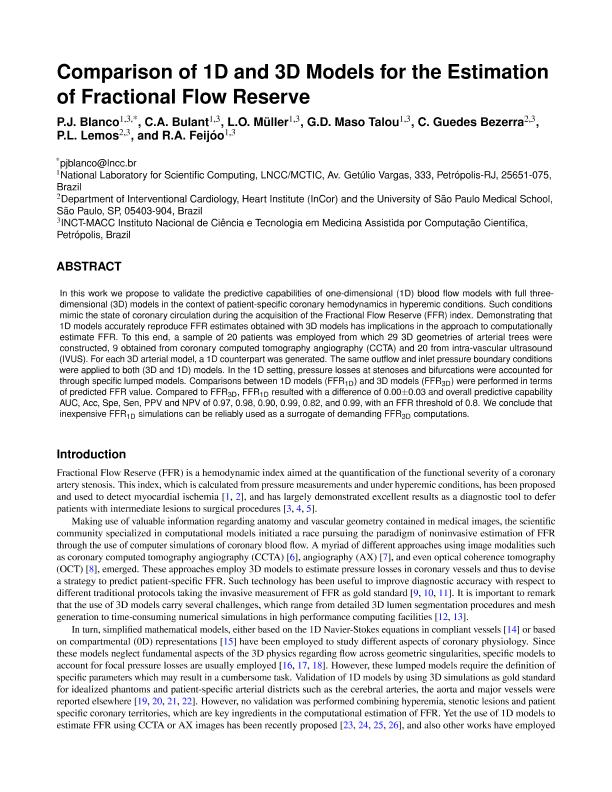Mostrar el registro sencillo del ítem
dc.contributor.author
Blanco, Pablo Javier

dc.contributor.author
Bulant, Carlos Alberto

dc.contributor.author
Müller, L. O.
dc.contributor.author
Maso Talou, Gonzalo Daniel

dc.contributor.author
Guedes Bezerra, C.
dc.contributor.author
Lemos, P. L.
dc.contributor.author
Feijóo, Raúl Antonino

dc.date.available
2020-08-13T15:44:28Z
dc.date.issued
2018-11
dc.identifier.citation
Blanco, Pablo Javier; Bulant, Carlos Alberto; Müller, L. O.; Maso Talou, Gonzalo Daniel; Guedes Bezerra, C.; et al.; Comparison of 1D and 3D Models for the Estimation of Fractional Flow Reserve; Nature Publishing Group; Scientific Reports; 8; 1; 11-2018; 1-19
dc.identifier.issn
2045-2322
dc.identifier.uri
http://hdl.handle.net/11336/111630
dc.description.abstract
In this work we propose to validate the predictive capabilities of one-dimensional (1D) blood flow models with full three-dimensional (3D) models in the context of patient-specific coronary hemodynamics in hyperemic conditions. Such conditions mimic the state of coronary circulation during the acquisition of the Fractional Flow Reserve (FFR) index. Demonstrating that 1D models accurately reproduce FFR estimates obtained with 3D models has implications in the approach to computationally estimate FFR. To this end, a sample of 20 patients was employed from which 29 3D geometries of arterial trees were constructed, 9 obtained from coronary computed tomography angiography (CCTA) and 20 from intra-vascular ultrasound (IVUS). For each 3D arterial model, a 1D counterpart was generated. The same outflow and inlet pressure boundary conditions were applied to both (3D and 1D) models. In the 1D setting, pressure losses at stenoses and bifurcations were accounted for through specific lumped models. Comparisons between 1D models (FFRd{1}) and 3D models (FFRd{3}) were performed in terms of predicted $ext{FFR}$ value. Compared to FFRd{3}, FFRd{1} resulted with a difference of 0.00$pm$0.03 and overall predictive capability AUC, Acc, Spe, Sen, PPV and NPV of 0.97, 0.98, 0.90, 0.99, 0.82, and 0.99, with an FFR threshold of 0.8. We conclude that inexpensive FFRd{1} simulations can be reliably used as a surrogate of demanding FFRd{3} computations.
dc.format
application/pdf
dc.language.iso
eng
dc.publisher
Nature Publishing Group

dc.rights
info:eu-repo/semantics/openAccess
dc.rights.uri
https://creativecommons.org/licenses/by/2.5/ar/
dc.subject
BLOOD FLOW
dc.subject
FFR
dc.subject
1D MODEL
dc.subject
3D MODEL
dc.subject
STENOSIS
dc.subject.classification
Otras Ingeniería Médica

dc.subject.classification
Ingeniería Médica

dc.subject.classification
INGENIERÍAS Y TECNOLOGÍAS

dc.subject.classification
Matemática Aplicada

dc.subject.classification
Matemáticas

dc.subject.classification
CIENCIAS NATURALES Y EXACTAS

dc.title
Comparison of 1D and 3D Models for the Estimation of Fractional Flow Reserve
dc.type
info:eu-repo/semantics/article
dc.type
info:ar-repo/semantics/artículo
dc.type
info:eu-repo/semantics/publishedVersion
dc.date.updated
2020-05-11T19:20:57Z
dc.journal.volume
8
dc.journal.number
1
dc.journal.pagination
1-19
dc.journal.pais
Estados Unidos

dc.description.fil
Fil: Blanco, Pablo Javier. National Laboratory for Scientific Computing; Brasil
dc.description.fil
Fil: Bulant, Carlos Alberto. National Laboratory for Scientific Computing; Brasil. Consejo Nacional de Investigaciones Científicas y Técnicas. Centro Científico Tecnológico Conicet - Tandil; Argentina
dc.description.fil
Fil: Müller, L. O.. National Laboratory for Scientific Computing; Brasil
dc.description.fil
Fil: Maso Talou, Gonzalo Daniel. National Laboratory for Scientific Computing; Brasil
dc.description.fil
Fil: Guedes Bezerra, C.. Universidade de Sao Paulo; Brasil
dc.description.fil
Fil: Lemos, P. L.. Universidade de Sao Paulo; Brasil
dc.description.fil
Fil: Feijóo, Raúl Antonino. National Laboratory for Scientific Computing; Brasil
dc.journal.title
Scientific Reports
dc.relation.alternativeid
info:eu-repo/semantics/altIdentifier/url/http://www.nature.com/articles/s41598-018-35344-0
dc.relation.alternativeid
info:eu-repo/semantics/altIdentifier/doi/http://dx.doi.org/10.1038/s41598-018-35344-0
Archivos asociados
